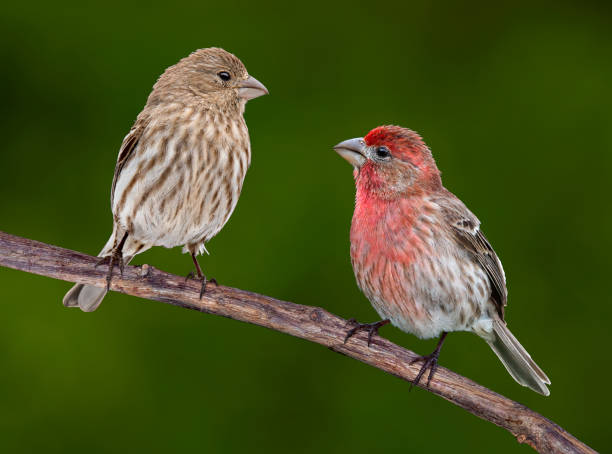ANIMAL: House Finch Haemorhous mexicanus Type of Animal: Songbird Habitat: Towns, buildings, tree areas, lawns, weedy areas, small conifers around human habitation, urban areas, parks, suburban areas, backyards, farmland, barns, stables, desert, desert grassland, chaparral, dry brush, oak savannah, scrub forest, streamsides, riparian areas, semi-open areas, forest edges, semi-open woodland edges, open forest, canyons, grasslands, shrubland, river/pond edges, not found above 6,000 ft Location(s): Found in continental US, Mexico, & S Canada. Introduced to Hawaii & SE Spain. Appearance: Rather small bird, males rosy red around face/upper breast w/ streaky brown back/belly/tail, females plain grayish-brown w/ thick blurry streaking & indistinct facial markings, both sexes have conical beaks. Food/Diet: Seeds, buds, vegetables, berries, fruits, flower parts, small flowers, grains, aphids Status in Wild: Stable Lifestyle: Flocks of around 50 birds, larger flocks can have as many as 500 birds Additional Info: Called: Male: Cock Female: Hen Young: Chick Group: Flock Weight: 0.6-0.9 oz Gestation: 2 weeks Life Span: 9-11 years Height: 5.1-5.5 in Body Length: 5.1-5.5 in Tail Length: 0.5 in Main predators of adults are felids, canids, raptors, skunks, raccoons, snakes, rats, corvids, & bears. Blue jays, squirrels, chipmunks, & grackles prey on chicks. These birds have expanded their range both naturally & by way of humans. Many birds in E half of North America derive from escaped cagebirds. In E part of range, they compete w/ purple finches & other native birds. These birds invasive in Hawaii. Different birds have different dialects throughout range. These birds are highly adaptable. Female finches prefer redder males. These birds very common at bird feeders. These birds can cause damage to grain & fruit crops. Eggs laid from February-August. 1-6 broods born per year w/ 2-6 eggs in each brood. They fledge at 11-19 days old but stay w/ parents for longer. Nests susceptible to mites later in nesting season. They’re cavity nesters. These birds highly susceptible to finch eye disease/avian conjunctivitis, which causes red/swollen/crusty/runny eyes. This disease caused by bacteria accumulated on dirty bird feeders. Fun Fact(s): In parts of E US in 1800s & 1st half of 1900s, these finches were sold as “Hollywood finches” to encourage more buyers. In many areas, these are one of the only songbirds that dominate non-native house sparrows. Sometimes called papaya birds in Hawaii since it’s their favorite fruit there.
